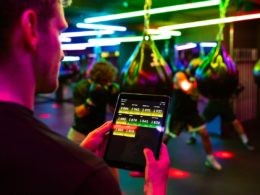Online stores are bleeding potential sales. Right now, shoppers are landing on product pages, scrolling through hundreds of options, feeling overwhelmed, and clicking away without buying anything. The numbers tell a brutal story: most Shopify stores convert at a dismal 1.4%, while the global e-commerce average hovers around 1.65% as of 2024.
That means for every 100 visitors who come to an online store, roughly 98 leave empty-handed. The traditional approach of displaying endless product grids and hoping customers figure things out on their own simply doesn’t work anymore. Shoppers need guidance, not more options to sift through.
The solution? A Shopify quiz app that transforms passive browsing into active engagement. These interactive tools don’t just boost numbers on a spreadsheet — they fundamentally change how customers discover products. Instead of searching through catalogs, shoppers answer questions tailored to their needs and receive personalized recommendations that feel genuinely helpful.
The Hidden Cost of Too Many Choices
Here’s something that sounds counterintuitive: giving customers more options often leads to fewer sales. Behavioral scientists have extensively documented this phenomenon, known as choice overload or decision paralysis.
Research published in the Journal of Consumer Psychology examined multiple studies and found strong evidence that excessive choices overwhelm consumers and hurt purchasing decisions. When faced with too many alternatives, people experience decision fatigue — their brains essentially get tired from evaluating options.
The problem intensifies in e-commerce environments where customers browse alone without sales assistance. Traditional filter systems assume shoppers know exactly what they want, but most arrive with vague ideas. They understand their problems but struggle to translate those needs into specific product attributes. Someone shopping for skincare might know their skin feels dry, but can’t decipher whether they need hyaluronic acid or ceramides.
How Interactive Quizzes Change the Game
A quiz app for Shopify works differently than standard product discovery. Rather than confronting shoppers with overwhelming catalogs, quizzes engage them through conversation. This approach taps into fundamental psychology that makes decision-making easier and more satisfying.
The Engagement Factor
Interactive content holds attention dramatically longer than static pages. When customers actively participate in a quiz rather than passively scrolling through product listings, something fundamental changes in how they experience the shopping process.
The commitment principle drives this behavior. Once people start a task, they feel compelled to finish it. Each answered question increases their investment in seeing the results. This psychological momentum carries through to purchase decisions, making quiz-generated recommendations far more effective than generic product suggestions.
When shoppers engage with questions tailored to their needs, they focus more intently and remember the experience better. This mental engagement explains why quizzes consistently outperform traditional product pages — customers aren’t just looking at products, they’re actively discovering which ones match their specific situation.
Personalization That Actually Works
Personalization has become an e-commerce buzzword, but most implementations fall flat. Generic “recommended for you” sections based on browsing history rarely feel genuinely personal. The best quiz app for Shopify delivers true personalization by gathering specific information about individual customer needs, preferences, and circumstances.
Take the Mario Badescu skincare quiz as a prime example.This interactive skin analysis tool helps customers discover personalized skincare regimens by asking questions about their skin type, concerns, and goals. Instead of browsing through dozens of products, shoppers answer a series of targeted questions and receive customized product recommendations – with the option to add recommended items or request free samples directly to their cart. The quiz demonstrates how effective product discovery tools transform the shopping experience. Let’s look at the concrete performance data:
- 55,000+ skin profiles recorded (total number of quiz completions)
- Completion rate: >80% (over 80% of people who start the quiz finish it)
- Quiz built with: Visual Quiz Builder platform
- Features: Personalized skincare regimen recommendations with the option to add products or free samples to the cart
- Result page integration: Connected to cart drawer and reviews app

The Mobile Commerce Reality
Mobile devices now account for 57% of global ecommerce sales, with that number projected to reach 63% by 2028. In 2024 alone, mobile commerce sales hit $2.07 trillion worldwide. This shift means that a Shopify quiz app must work seamlessly on small screens where traditional product browsing becomes even more frustrating.
Mobile shoppers exhibit different behavior patterns than desktop users. They browse during commutes, while waiting in line, or during short breaks — moments when they want quick, easy decision-making. A well-designed quiz app that Shopify stores can leverage fits perfectly into these micro-moments. Instead of forcing mobile users to navigate complex category trees or apply multiple filters, quizzes guide them through a few taps to reach relevant products.
The data reinforces this approach: 75% of e-commerce site traffic now comes from mobile devices, yet mobile conversion rates have historically lagged behind desktop. The best quiz app for Shopify implementations helps close this gap by creating mobile-optimized experiences that feel natural on smartphones.
Real Numbers Behind Quiz Performance
Beyond anecdotal success stories, quiz marketing research reveals consistent patterns:
Performance Benchmarks from Research:
- Completion rates: According to the Riddle Quiz Marketing Benchmarks Report, quizzes achieve an impressive 81.5% completion rate — meaning 4 out of 5 visitors who start a quiz actually finish it. This starkly contrasts with traditional pop-up forms that struggle to capture attention.
- Time spent engaging: Research from Insivia shows that users spend an average of 13 minutes interacting with dynamic content compared to just 8.5 minutes with static content. This extended engagement time creates more opportunities to build trust and influence purchase decisions.
- Lead generation conversion: Interactive quizzes convert visitors to leads at rates of 30-50%, dramatically outperforming traditional lead magnets that typically convert at 3-10% according to ScoreApp research When shoppers actively participate rather than passively browse, they’re more likely to provide contact information and continue the buying journey.
Building Quizzes That Convert
Not all quizzes deliver equal results. The difference between a mediocre quiz and a high-converting one often comes down to execution details.
Question Strategy
Effective quiz questions feel natural and relevant. They avoid technical jargon while focusing on customer outcomes rather than product specifications. The best performing quizzes follow a specific structure:
Start with broad lifestyle or preference questions to establish context and build rapport. Someone shopping for supplements might first answer questions about their daily routine, energy levels, or wellness goals rather than immediately diving into ingredient lists.
Progress to more specific needs through targeted questions that narrow down options. Each question should eliminate some possibilities while highlighting others based on previous answers.
Include considerations beyond basic features — budget, lifestyle factors, aesthetic preferences — that influence satisfaction but rarely appear in standard product filters.
End with confirmation questions that build confidence in the recommendation. This might involve summarizing their needs or asking them to prioritize certain benefits.
Limiting quizzes to 5-8 essential questions respects customer time while gathering necessary information for accurate recommendations.
Incentive Implementation
Research shows that offering rewards like discount codes can boost quiz completion rates by up to 30%. The key lies in presenting these incentives clearly up front. Shoppers need to understand the value exchange: invest a few minutes answering questions, receive personalized recommendations, plus a special offer.
However, incentives work best when they feel like natural rewards rather than bribes. The quiz should provide inherent value through helpful recommendations. The discount then becomes a bonus that nudges hesitant shoppers toward purchase.
Technical Considerations for Success
A quiz Shopify app needs solid technical execution to deliver results. Mobile optimization becomes critical given that mobile devices generate the majority of traffic. Quiz interfaces must feature:
- Thumb-friendly button sizes that prevent misclicks on small screens
- Fast loading speeds since 47% of consumers expect pages to load in 2 seconds or less
- Clear progress indicators showing completion status to encourage finishing
- Simplified question formats that minimize typing on mobile keyboards
- Smooth transitions between questions that feel polished rather than clunky
Customer responses should feed into email segmentation, retargeting campaigns, and personalized follow-up sequences. This integration multiplies quiz value by enabling sophisticated nurturing of leads who don’t convert immediately.
Advanced Personalization Through Conditional Logic
The most sophisticated quiz app for Shopify stores uses conditional logic that adapts questions based on previous answers. Someone shopping for exercise equipment who lives in a small apartment shouldn’t see questions about large home gym setups. The quiz automatically skips irrelevant options and focuses on space-saving solutions.
This dynamic adaptation reduces quiz length, makes recommendations more accurate, and creates personalized experiences that customers appreciate and remember.
Measuring and Optimizing Performance
Implementing a quiz Shopify app represents just the beginning. Continuous optimization based on performance data distinguishes between good results and exceptional ones. Track key metrics like completion rates, drop-off points, and conversion rates.
A/B testing proves essential for improvement. Test different question sequences, visual designs, and incentive offers to identify what resonates most. Even small changes — such as rewording a question or adjusting button colors — can produce measurable improvements when applied systematically.
The Competitive Advantage
The e-commerce landscape grows more competitive daily. With average conversion rates stuck below 2% and customer acquisition costs rising, stores need every advantage available. A Shopify quiz app provides multiple competitive benefits simultaneously:
Reduced decision fatigue: By guiding customers through simplified decision-making, quizzes eliminate the paralysis caused by too many options.
Increased engagement: Interactive experiences keep shoppers on site longer, building familiarity and trust that translates into sales.
Better customer data: Quiz responses provide zero-party data — information customers willingly share — that powers more effective marketing and product development.
Higher perceived value: Personalized recommendations feel more valuable than self-service browsing, justifying premium pricing and building loyalty.
Improved mobile experience: Quizzes work particularly well on smartphones, where traditional product discovery struggles.
The stores winning in e-commerce aren’t necessarily those with the most products or the lowest prices. They’re the ones making purchase decisions easier and more enjoyable. Interactive quizzes accomplish exactly that, transforming uncertain browsers into confident buyers.
Getting Started
Implementing quiz-based product discovery doesn’t require massive technical resources or complete site redesigns. Modern Shopify quiz apps offer intuitive interfaces for building quizzes without coding knowledge. The key lies in starting with customer insights — understanding what questions people ask, what concerns prevent purchases, and what information helps them decide.
Begin by mapping common customer journeys and identifying decision points where guidance would help. Create simple initial quizzes focused on specific product categories rather than trying to quiz-ify the entire catalog at once. Test, gather data, and iterate based on real performance rather than assumptions.
As mobile commerce continues growing and consumer expectations for personalization intensify, interactive product discovery will shift from a competitive advantage to a basic requirement. The stores that master quiz-based engagement now will capture disproportionate market share while competitors struggle with outdated browse-and-search models that leave customers overwhelmed and unsatisfied.
Frequently Asked Questions
Q: How long should a Shopify quiz app be?
A: Limit quizzes to 5-8 essential questions. This respects customer time while gathering necessary information for accurate product recommendations. Shorter quizzes achieve higher completion rates.
Q: Do quiz apps work well on mobile devices?
A: Yes, when properly designed. Mobile-optimized quizzes with thumb-friendly buttons, fast loading speeds, and minimal typing requirements perform exceptionally well, especially since mobile devices generate the majority of e-commerce traffic.
Q: What completion rate should I expect from my quiz?
A: Well-designed quizzes typically achieve completion rates above 75-80%. If your completion rate drops below this, analyze where customers abandon the quiz and simplify those questions.
Q: Should I offer incentives for completing quizzes?
A: Yes. Offering rewards like discount codes or free shipping can significantly boost completion rates. Present these incentives clearly at the beginning so customers understand the value exchange.
Q: How do I know if my quiz is actually driving sales?
A: Track metrics like conversion rates from quiz completions, revenue attribution, and average order value from quiz users versus non-quiz users. A/B testing different quiz elements helps optimize performance over time.












